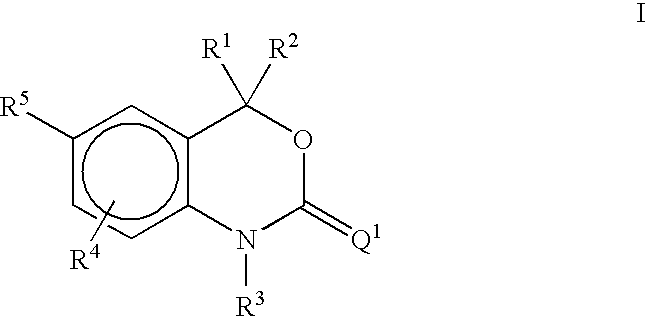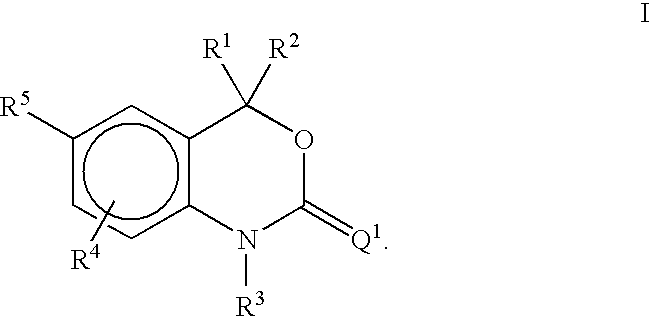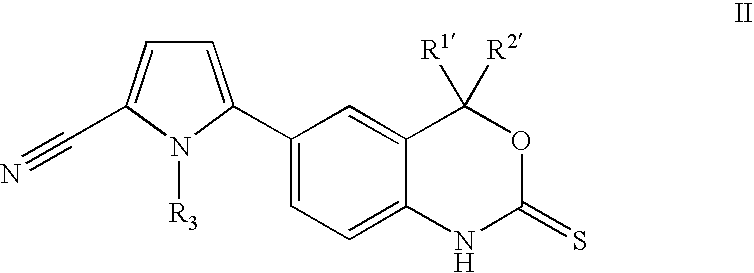Cyclothiocarbamate derivatives as progesterone receptor modulators and methods of treating skin disorders
a technology of progesterone receptor and cyclothiocarbamate, which is applied in the field of skin disorders, can solve problems such as unsatisfactory side effects
- Summary
- Abstract
- Description
- Claims
- Application Information
AI Technical Summary
Benefits of technology
Problems solved by technology
Method used
Image
Examples
example 1
1-Methyl-5-(2-thioxo-1,2-dihydrospiro[3,1-benzoxazine-4,1′-cyclobutan]-6-yl)-1H-pyrrole-2-carbonitrile
[0182]A. tert-Butyl [2-(1-Hydroxycyclobutyl)phenyl]carbamate
[0183]To phenyl-carbamic acid tert-butyl ester (2 g, 10.4 mmol) in ether (30 mL) at 0° C. was added t-BuLi (15 mL, 26 mmol, 1.7 M) and the reaction solution stirred for 3 hours prior to the addition of cyclobutanone (1.2 mL, 15.6 mmol). The reaction mixture was allowed to warm to room temperature. Upon completion by thin-layer chromatography (TLC), the reaction was poured into ice-cold saturated ammonium chloride (100 mL) and extracted with ethyl acetate (50 mL). The organics were dried over sodium sulfate, concentrated, and purified on a silica gel column (10% ethyl acetate / hexane) to give tert-butyl [2-(1-hydroxycyclobutyl)-phenyl]carbamate (0.86 g, 32%) as a white solid. 1H NMR (DMSO-d6): δ 8.48 (s, 1H), 7.8 (d, 1H, J=7.92 Hz ), 7.35 (dd, 1H, J=7.7, 1.4 Hz), 7.25 (td, 1H, J=7.5, 1.6 Hz), 7.03 (td, 1H, J=7.5, 1.3 Hz), 2.5...
example 2
5-(4,4-Diethyl-2-thioxo-1,4-dihydro-2H-3,1-benzoxazin-6-yl)-1-methyl-1H-pyrrole-2-carbonitrile
[0191]A. 5-(4,4-Diethyl-2-oxo-1,4-dihydro-2H-3,1-benzoxazin-6-yl)-1-methyl-1H-pyrrole-2-carbonitrile
[0192]To a solution of 1-methyl-1H-pyrrole-2-carbonitrile (4.1 g, 35 mmol) and triisopropylborate (8.9 mL, 38.5 mmol) in THF (80 mL) at 0° C. was added lithium diisopropylamide (22.8 mL, 45.5 mmol). The reaction mixture was allowed to warm to room temperature. Upon completion by TLC, the reaction was added dropwise to a 65° C. solution of 6-bromo-4,4-diethyl-1,4-dihydro-benzo[d][1,3]oxazin-2-one (2.0 g, 7.0 mmol), potassium carbonate (2.9 g, 21 mmol) dissolved in (25 mL water), and tetrakistriphenylphosphine palladium (0) (0.4 g, 0.35 mmol) in tetrahydrofuran (20 mL). Upon completion by TLC of the reaction, it was poured into a saturated solution of ammonium chloride (200 mL), extracted with ethyl acetate (100 mL), dried with magnesium sulfate, and concentrated. Trituration of the residue wit...
example 3
5-(4-ethyl-4-methyl-2-thioxo-1,4-dihydro-2H-3,1-benzoxazin-6-yl)-1-methyl-1H-pyrrole-2-carbonitrile
[0194]A. 6-Bromo-4-ethyl-4-methyl-1,4-dihydro-2H-3,1-benzoxazin-2-one
[0195]To a stirred solution of 1-(2-amino-5-bromophenyl)-ethanone (10.00 g, 46.70 mmol) in THF (150 mL) was added 3.0M ethyl magnesium bromide (50 mL, 150 mmol) slowly at 0° C. over 20 minutes. The reaction was stirred 1 hr at 0° C., quenched with ammonium chloride solution (sat.) and extracted with ethyl acetate several times. The organic layer was washed with brine and dried over magnesium sulfate. The concentrated crude material was dissolved in THF (150 mL). 1,1′-Carbonyldiimidazole (9.00 g, 56.04 mmol) was added and the reaction was stirred overnight at room temperature. The reaction was partitioned between ammonium chloride solution (sat.) and ethyl acetate. The organic layer was dried over magnesium sulfate and concentrated. Flash silica gel column separation with 30% ethyl acetate / hexane followed by trituratio...
PUM
| Property | Measurement | Unit |
|---|---|---|
| temperature | aaaaa | aaaaa |
| temperature | aaaaa | aaaaa |
| temperature | aaaaa | aaaaa |
Abstract
Description
Claims
Application Information
 Login to View More
Login to View More - R&D
- Intellectual Property
- Life Sciences
- Materials
- Tech Scout
- Unparalleled Data Quality
- Higher Quality Content
- 60% Fewer Hallucinations
Browse by: Latest US Patents, China's latest patents, Technical Efficacy Thesaurus, Application Domain, Technology Topic, Popular Technical Reports.
© 2025 PatSnap. All rights reserved.Legal|Privacy policy|Modern Slavery Act Transparency Statement|Sitemap|About US| Contact US: help@patsnap.com



